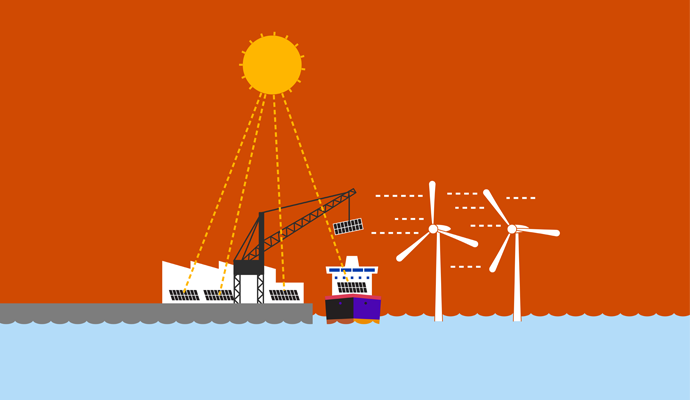Ports of innovation: How ABP is turning maritime hubs into clean energy powerhouses
Max Harris, group head of strategy and sustainability at Associated British Ports, the largest ports operator in the United Kingdom, explains how the company is using tech to accelerate the energy transition across industrial sectors—and create new business models.

This interview is part of the Inside the Mind of the CxO series, which explores a wide range of critical decisions faced by chief executives around the world.
Maritime ports have long been engines of the global economy. Of crucial importance as trading and supply chain hubs, they have a deep history in commerce, with some dating back thousands of years. Now, they’re emerging as leaders of a 21st-century tech-enabled energy transition. Responsible for 80% of worldwide trade, ports host and service a range of adjacent industries. They’re uniquely positioned at the nexus of an ecosystem of businesses urgently responding to emerging technologies, geopolitical risks, and climate change.
The climate crisis, in particular, has been a catalyst of innovation for Associated British Ports (ABP), which handles a quarter of the UK’s seaborne trade. The company has been privately held since 1982, and it’s now owned by a mix of pension and sovereign wealth funds. ABP’s 21 port locations and 8,600-acre land portfolio are central to its strategy: rethinking and repurposing land use for renewable energy projects like offshore wind and solar installation, and exploring diverse business models, including partnerships with climate tech start-ups.
Max Harris, ABP’s group head of strategy and sustainability, oversees its new Energy Ventures Accelerator (EVA) program. The initiative is poised to help deepen the port operator’s relationship with its carbon-intensive industry customers, including shipping companies and steel manufacturers, by connecting them with climate tech start-ups that can help tackle big challenges, like decarbonizing industrial heat. It’s also a chance for ABP to invest in potential customers of the future, as these start-ups seek to scale commercially.
Harris recently talked to strategy+business about how the evolving role of ports creates opportunities for ABP to test new business models, address its own climate challenges, and help its customers advance hydrogen power, offshore wind, carbon capture and storage, and other sustainability-related goals.
The following is an edited version of the conversation.
S+B:
How
have
the
needs
of
your
traditional
ports
customers
changed?
MAX
HARRIS:
Decarbonization
is,
overwhelmingly,
the
main
megatrend
that
customers
want
to
talk
about.
These
customers
include
shipping
lines
and
logistics
companies
with
heavy-goods
vehicles
coming
in
on
ferries.
Aside
from
that,
it’s
about
supply
chain
cost
efficiency
and
having
greater
visibility
of
interconnected
operations.
But,
absolutely,
decarbonization
is
a
key
focus.
Access
to
green
power,
greener
fuels,
and
lower-carbon
fuels
is
important
for
our
customers,
and
that
access
is
seen
as
a
key
enabler
of
their
broader
strategic
ambitions.
One of the biggest challenges that we’re facing in the UK, in terms of our net-zero trajectory, is how to decarbonize industrial heat, which is required for all sorts of different manufacturing processes. Hydrogen is the leading candidate to help to decarbonize the creation of industrial heat. But the challenge is to provide that clean hydrogen at a competitive cost, where the green premium that manufacturers and big industrial users pay is not so significant that it becomes unattractive. So ABP is working with a number of innovative hydrogen producers that are looking at different technologies to reduce the cost of hydrogen production, which will then feed into industrial users, so that they can decarbonize their heat production. It’s a really exciting journey, where we can look to make hydrogen more cost-competitive whilst also driving the net-zero agenda.
S+B:
This
seems
like
a
radical
departure
from
the
role
that’s
typically
associated
with
ports.
Can
you
tell
us
more
about
ABP’s
evolving
remit
as
a
modern
port?
HARRIS:
The
fundamental
role
of
ports
has
been
the
same
throughout
history:
lifting
cargo
on
and
off
vessels,
and
getting
it
to
end-customers.
That’s
still,
by
far,
the
majority
of
our
business.
But
we
deploy
a
mixture
of
business
models.
We
have
land
assets
and
infrastructure
assets.
Customers
come
and
use
our
land,
and
then
they’ll
pay
us
to
rent
it,
so
that’s
basically
a
landowner
model.
But
we’re
also
an
infrastructure
business,
because
our
customers
use
our
cranes,
our
quaysides,
our
jetties
and
marine
infrastructure,
and
sometimes
they
will
operate
the
terminals.
To meet the needs of our customers, we’ve broadened our business model from facilitating and enabling the import and export of cargo to also include enabling the energy transition. It doesn’t mean that we’re not focused on trade anymore: that will always be the foundation of our business. And, really, [these new business models] are just an expansion of what we’re trying to do by looking at the energy transition and how we support hydrogen, carbon capture and storage [CCS], and offshore wind, for example.
S+B:
How
are
you
leveraging
your
existing
assets
to
expand
your
business
models?
HARRIS:
There
has
been
a
business
shift
at
ABP
toward
an
increased
focus
on
land
assets.
We
see
this
as
part
of
a
broader
adjustment
in
the
industrial
landscape
of
the
UK,
where
there’s
a
shift
toward
those
low-carbon
infrastructure
types—hydrogen,
offshore
wind,
or
manufacturing
facilities
for
CCS.
Over the last few years, we’ve seen an increase in manufacturing taking place at our ports. A great example of that is Siemens Gamesa’s Green Port Hull [GPH] offshore wind [turbine] blade-manufacturing facility, located at the Port of Hull. That’s, by far, the biggest example of offshore wind manufacturing in the UK, using state-of-the-art technology. Since the project became operational at our port in 2016, GPH has supported both growth in the UK offshore wind sector and the broader European deployment of offshore wind.
Likewise, we’re seeing that manufacturers want to be located at the heart of large industrial ecosystems, including our ports in the Humber region of the UK, in South Wales, in Southampton, and in East Anglia. We see the use of our land beside the water as a critical driver for us in terms of attracting investment and manufacturing, which brings with it jobs and investment in coastal communities.
Ports are also perfect locations to test next-generation technologies. At the Port of Southampton, we worked with Verizon to deploy the first private 5G network on an industrial site in the UK. [Our initiatives] are really focused on industrial, internet of things use cases. And one great example of that is how we work with our automotive customers that are bringing vehicles into the UK market. With better 5G connectivity, we can use our terminal operating systems to optimize the path of the vehicles from the ship or to the storage location, based on either time or cost, and now, carbon. Having better 5G connectivity really makes a difference not only to supply chain cost reduction but also to CO2 reduction.
S+B:
Can
you
tell
us
about
ABP’s
approach
to
its
own
climate
change
challenges?
HARRIS:
We
can’t
credibly
talk
about
enabling
the
energy
transition
without
taking
care
of
our
own
house
when
it
comes
to
sustainability.
There
are,
inevitably,
a
number
of
challenges
that
we’ll
face
over
the
next
ten,
20,
30
years.
Rising
sea
levels
are
certainly
high
among
them,
and
that’s
one
of
our
biggest
long-term
risks.
So,
we’re
making
sure
that
our
quay
walls
are
the
right
height
to
protect
against
floods
and
storm
surges.
We
also
need
to
work
with
public
sector
authorities
around
broader
flood
defenses
and
support
them
in
their
investments.
As part of our sustainability strategy, we have an operational net-zero target of 2040. One of the ways we are pursuing this goal is to invest in solar energy generation. ABP’s ports have a lot of warehouses with roof-mounted solar panels, to optimize the use of space for renewable energy generation. Alongside onshore wind turbines, we have 32 megawatts of installed capacity for clean energy generation around our ports, and that reduces our reliance on the UK’s national grid and allows us to use cleaner, cheaper power. In addition, our customers can take advantage of that cleaner, cheaper power at our ports: We own the local grid around our port assets. Many of our ports are large-scale industrial sites reaching over 1,000 acres in size. So, we sell power to our tenants and our customers on those port sites.
S+B:
With
sustainability
playing
a
greater
part
in
business
strategy,
we’re
seeing
C-suite
roles
evolve.
Can
you
tell
us
a
bit
about
your
role,
and
why
ABP
has
decided
to
unite
strategy
and
sustainability
in
one
office?
HARRIS:
There
are
three
elements
to
my
role.
Firstly,
I
lead
on
corporate
strategy
development
and
implementation.
This
goes
hand
in
hand
with
developing
and
delivering
our
sustainability
strategy.
And
then
a
new
piece
of
my
role,
one
that
crosses
both
strategy
and
sustainability,
is
taking
the
first
steps
into
innovation
and
supporting
start-up
ventures.
This
is
a
new
commercial
model
we’re
looking
to
explore—to
make
sure
that
we
can
support
the
changing
needs
of
our
customers
as
the
energy
transition
takes
hold
and
as
decarbonization
becomes
the
norm
for
the
UK
economy.
Sustainability is inherent in our business model and our commercial focus, because all of our major customers are either challenged by the decarbonization imperative, seeking to reduce emissions and pivot their business to a cleaner future, or they’re looking to scale their clean energy initiatives, which requires a lot of investment infrastructure enablers—which we can help provide. Our coverage across those different segments of the UK economy means that our role in enabling the energy transition, and broader sustainability objectives, is massive.
Sustainability is inherent in our business model, because all of our major customers are either challenged by the decarbonization imperative or they’re looking to scale their clean energy initiatives.”
S+B:
Tell
us
about
ABP’s
Energy
Ventures
Accelerator.
How
did
the
idea
for
this
climate
tech
start-up
platform
first
take
shape?
HARRIS:
It’s
gone
from
a
seed
of
an
idea
around
corporate
venturing
to
a
groupwide
strategy
anchored
in
using
our
land
more
effectively
and
supporting
growing
green
energy
markets
such
as
hydrogen
and
offshore
wind.
We
know
who
the
established
players
are
in
those
markets,
but
we’d
also
like
to
explore
who
the
emerging
players
are
and
how
we
can
work
with
them.
[Start-ups]
don’t
necessarily
have
the
balance
sheet
strength
to
be
a
traditional
ABP
customer,
because
we
look
to
sign
ten,
15,
20-plus-year
contracts.
They
can’t
necessarily
commit
to
that
length
of
contract.
So,
we
needed
to
come
up
with
a
different
commercial
model
in
order
to
work
with
those
types
of
start-ups—moving
into
commercial
scale
operations
and
looking
to
really
commercialize
the
products
that
they’re
manufacturing.
S+B:
Give
us
an
overview
of
the
accelerator.
What
types
of
technology
solutions
are
you
zeroing
in
on?
HARRIS:
The
Energy
Ventures
Accelerator
is
a
12-month
program
to
identify
the
highest-potential
energy
transition
start-ups
in
the
hardware
space.
Our
existing
customers—steelworks,
oil
refineries,
cement
works—are
looking
to
decarbonize,
and
they
need
technology
and
these
hardware
solutions
to
get
there.
And
we
want
to
build
relationships
with
the
big
players
of
the
future:
the
start-ups
that
will
become
scale-ups
that
will
become
fully
established
industrial
players.
Our
thesis
is
that
our
existing
customers
will
also
be
the
start-ups’
customers.
So,
we’re
looking
to
attract
the
best
and
brightest
international
start-ups
to
come
to
our
ports
to
leverage
our
land
and
infrastructure
assets,
and
also
to
meet
our
customer
base
and
meet
the
local
stakeholders,
local
government,
local
councils,
and
local
enterprise
partnerships.
We’re working with Plug and Play, a large Silicon Valley–headquartered innovation platform and VC investor; but they don’t just do software—they’re also focused on hard tech deployment. The Energy Ventures Accelerator is all about hardware. It’s not SaaS [software as a service] solutions or AI. This is about physical, tangible products being manufactured, like offshore wind components. There are over 65,000 start-ups in Plug and Play’s global network. They have a window into a whole different world than we’re accustomed to working in, and so they can help us broaden our reach.
S+B:
Give
us
an
example
of
how
these
sorts
of
partnerships
might
work.
HARRIS:
One
good
example
of
ABP
working
with
start-ups
to
support
innovative
solutions
is
when
we
worked
with
Terberg,
which
manufactures
terminal
tractors.
They
wanted
to
test
hydrogen
propulsion
units
within
their
terminal
tractors.
So
we
worked
with
them
and
with
Air
Products,
a
customer
of
ours,
to
trial
these
terminal
tractors.
It
went
really
well,
and
our
staff
and
employees
tested
the
fuels,
using
hydrogen
versus
diesel.
And
we’re
going
to
do
a
lot
more
of
that,
where
we’re
working
with
early-stage
businesses.
We’re looking at a few different start-up collaboration models. On the one hand, there’s pilots and proof-of-concepts, through which start-ups can test their technology at our port sites, also working with our existing customers to trial real-world applications. On the other, we might take equity stakes in start-up businesses in exchange for discounted leases and commercial support. But we could also look at special-purpose vehicles—companies set up specifically to build a product in one of our ports, and then we do a revenue-sharing agreement, for example.
We also provide go-to-market support, connecting start-ups with our customers and with the broader industrial scene, especially in places like the Humber and South Wales. Part of those investments could be cash-based. And then there are other models, like a go-to-market partnership, where ABP plus the start-up can offer solutions to shipping lines, for example, to help decarbonize their operations.
S+B:
Fast-forward
ten
years,
when
these
new
projects
and
pilots
will
have
had
a
chance
to
develop.
What
will
ABP’s
port
operations
and
business
look
like?
HARRIS:
There’ll
be
at-scale
deployment
of
carbon
capture
on
large
industrial
units
around
our
ports.
That
captured
CO2
will
be
used
for
alternative
fuels—e-fuels,
synthesized
hydrogen,
and
CO2
that
supports
low-carbon
[maritime]
shipping
through
e-methanol
and
low-carbon
aviation
through
sustainable
aviation
fuel.
Our customer base will be more diverse. Our existing customers will have made huge progress on their decarbonization journeys and will be joined by new types of customers at our ports—big hydrogen companies, floating offshore wind developers and manufacturers. I see our ports as focal points for a really vibrant, dynamic mix of medium-sized companies that are growing and that are really innovating, together with large players that are also innovating in order to decarbonize their operations. I think ports are going to be a real center of gravity for the industrial energy transition, and so all the investment that we’re making and all the investment that our customers will make on top of that is going to make a really big impact on net zero in the UK.
Author profile:
- Shana Ting Lipton is a senior editor of strategy+business.


